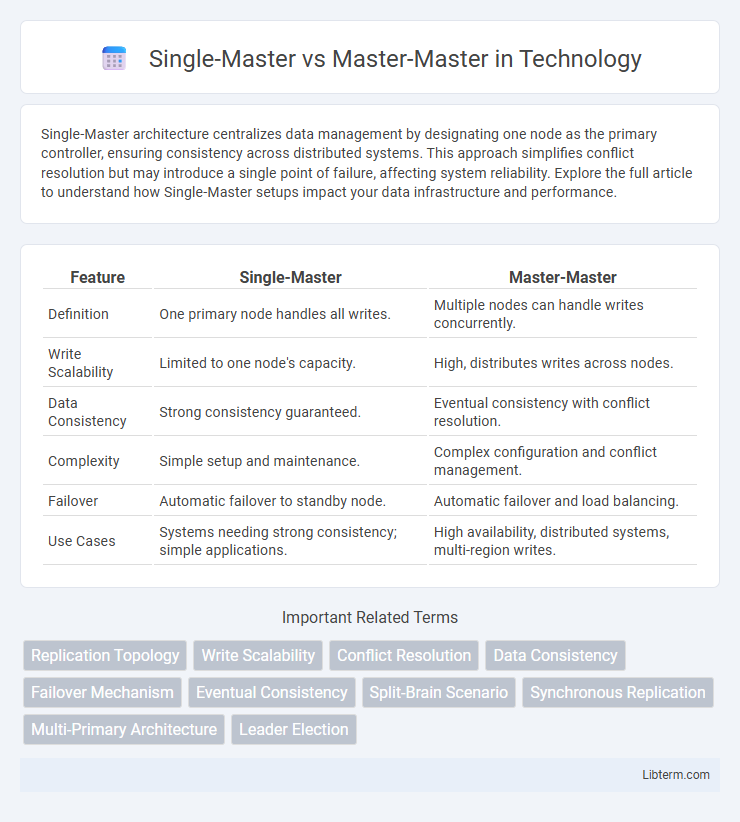Single-Master architecture centralizes data management by designating one node as the primary controller, ensuring consistency across distributed systems. This approach simplifies conflict resolution but may introduce a single point of failure, affecting system reliability. Explore the full article to understand how Single-Master setups impact your data infrastructure and performance.
Table of Comparison
| Feature | Single-Master | Master-Master |
|---|---|---|
| Definition | One primary node handles all writes. | Multiple nodes can handle writes concurrently. |
| Write Scalability | Limited to one node's capacity. | High, distributes writes across nodes. |
| Data Consistency | Strong consistency guaranteed. | Eventual consistency with conflict resolution. |
| Complexity | Simple setup and maintenance. | Complex configuration and conflict management. |
| Failover | Automatic failover to standby node. | Automatic failover and load balancing. |
| Use Cases | Systems needing strong consistency; simple applications. | High availability, distributed systems, multi-region writes. |
Understanding Single-Master and Master-Master Architectures
Single-Master architecture centralizes write operations on one master node, ensuring data consistency through a single point of update, while read operations can be distributed across multiple replica nodes. Master-Master architecture enables multiple master nodes to handle write operations simultaneously, improving availability and fault tolerance but requiring conflict resolution mechanisms to maintain data integrity. Understanding these architectures helps optimize database performance and reliability according to specific application needs and workloads.
Core Differences Between Single-Master and Master-Master
Single-Master replication features one primary node handling all write operations while multiple read replicas synchronize from it, ensuring data consistency with simpler conflict management. Master-Master replication allows multiple nodes to handle write operations simultaneously, enabling higher availability and fault tolerance but requiring conflict resolution mechanisms due to concurrent updates. Core differences revolve around write handling, conflict resolution complexity, and data consistency models inherent to single-master versus multi-master architectures.
Advantages of Single-Master Replication
Single-Master replication simplifies conflict resolution by designating one primary node for all write operations, ensuring data consistency and reducing synchronization errors. This approach optimizes performance since read requests on multiple replicas do not compete with write operations, leading to faster query execution and streamlined resource allocation. Maintenance and troubleshooting are more straightforward with a single write source, minimizing complexity and enhancing system reliability.
Benefits of Master-Master Replication
Master-Master replication enables high availability and fault tolerance by allowing multiple database nodes to handle read and write operations simultaneously, reducing downtime and improving system reliability. This configuration supports load balancing, distributing the workload evenly across servers, which enhances performance and scalability for large, distributed applications. Conflict detection and resolution mechanisms in master-master setups ensure data consistency, making it ideal for environments demanding real-time synchronization and continuous uptime.
Common Use Cases for Single-Master Systems
Single-master database systems are commonly used in applications where data consistency and simplified conflict resolution are critical, such as financial transactions and inventory management. These systems excel in scenarios requiring a single authoritative data source to prevent data anomalies and maintain integrity during write operations. Single-master architectures are preferred in campaigns with high read-to-write ratios, where scalability can be achieved through read replicas without compromising update consistency.
Ideal Applications for Master-Master Configurations
Master-Master configurations excel in scenarios requiring high availability and fault tolerance by allowing multiple nodes to handle read and write operations simultaneously. Ideal applications include distributed databases, global e-commerce platforms, and collaborative tools where data consistency and real-time synchronization across geographically dispersed locations are critical. These setups enhance load balancing, minimize downtime risk, and support seamless failover mechanisms crucial for mission-critical systems.
Challenges in Managing Single-Master Topologies
Single-Master topologies face challenges such as write bottlenecks, where all data modifications funnel through a single node, limiting scalability and increasing latency under heavy loads. Fault tolerance is another critical issue; if the master node fails, the entire system experiences downtime until failover or recovery procedures complete. Conflict resolution is simplified compared to Master-Master, but the risk of data loss during master failure remains significant without robust backup and replication strategies.
Issues and Complexities in Master-Master Replication
Master-master replication introduces complexities such as conflict resolution challenges, where simultaneous writes on multiple nodes can lead to data inconsistencies requiring sophisticated conflict detection and merging strategies. It also demands increased overhead for synchronization and latency management to maintain eventual consistency across all nodes. Network partitions and failure handling become more complicated, often necessitating quorum-based protocols or consensus algorithms to prevent split-brain scenarios and ensure data integrity.
Performance and Scalability Comparison
Single-master replication offers simplified conflict resolution and typically lower latency for write operations due to centralized data management, enhancing performance in write-heavy workloads. Master-master replication improves scalability by enabling multiple nodes to handle writes concurrently, distributing the load and improving fault tolerance, but may introduce higher conflict resolution overhead and latency. Performance in master-master setups depends on efficient conflict detection and resolution mechanisms to avoid bottlenecks, while single-master systems excel in scenarios demanding consistent write sequencing and simpler synchronization.
Choosing the Right Replication Architecture for Your Needs
Single-master replication offers simplicity and easier conflict resolution by designating one primary server for write operations, making it ideal for applications with predictable, centralized updates. Master-master replication enables higher availability and load balancing by allowing multiple writable nodes but requires complex conflict detection and resolution strategies to maintain data consistency. Evaluating factors such as workload distribution, fault tolerance requirements, and conflict management capabilities helps determine the optimal replication architecture for your specific database environment.
Single-Master Infographic

 libterm.com
libterm.com